There aren’t many new vehicles that are almost 25 years old. The GMC Savana van is, in fact, the only one.
If, of course, you don’t count its Chevy-badged cousin, the Express.
Both of these super-sized (and super-duty) vans haven’t changed much since 1996 – because why would they? No one else makes vans like them anymore: Body-on-frame construction, 12-15 passenger capacity and a big V8 instead of a turbo four . . . or a turbodiesel four . . . or a V6, without a turbo.
Ether one offers your pick of all three.
None of the others do.
The Savana van is GMC’s version of the Chevy Express van. Both are far-from-being mini vans. In standard wheelbase layout, they can carry 12 people; in long-wheelbase layout, they can handle 15.
That’s not the only way they’re unlike other vans currently on the market.
Their heavy-duty rear-wheel-drive/body-on-frame layout layout enables them to pull more cargo than sort-of rivals like the Ford Transit and Ram ProMaster – while being much less pricey than the rugged but high-dollar Mercedes-Benz Sprinter van.
Prices start at $32,000 for the base version of the GMC van – topping out at $35,900.
What’s New
Though the van itself is largely the same as it was back in ’96 – in terms of how it’s built and how it looks – it offers things that weren’t available back in ’96, including the now-available Corvette-derived 6.0 liter V8 and the almost-as-powerful (but much less thirsty) 2.8 liter turbo-diesel engine.
The 2020 comes standard with things inconceivable back in ’96, such as in-vehicle WiFi. And – optionally – Lane Departure Warning and Forward Collision alert, if you want those things.
The good news is they’re still optional – if you don’t.
What’s Good
Rear-wheel-drive/body-on-frame construction is tough and durable.
Nothing else can carry as many – and pull as much – for as little.
Almost endlessly configurable.
No high-roof option (Sprinter and ProMaster offer this).
Tilt wheel costs extra.
Turbo-diesel engine costs a lot extra ($3,995).
Under The Hood
The Savana comes standard with a 4.3 liter V6 that makes 276 horsepower – almost as much power as a modern V8 and much more power than comes standard in other large vans like the the Mercedes Sprinter, which don’t offer V8s.
The Sprinter comes standard with a turbocharged 2.0 liter four cylinder that makes 188 horsepower – which is kind of like trying to propel an aircraft carrier with sail power.
Incidentally: The Savan’s 4.3 V6 engine actually is a V8. Or at least, it was.
It’s a small-bock Chevy V8, less two cylinders – but the same architecture. It’s a simple, overhead valve (and two-valve) pushrod engine, 90 degree cylinder banks and a timing chain (not belt). If you want a long-lived, low-maintenance engine, this one’s it.
You can upgrade any Savana trim to either a 6.0 liter V8 that makes 341 horsepower and 373 ft.-lbs. of torque or a 2.8 liter turbo-diesel four that makes nearly the same torque as the V8 (369 ft.-lbs.) but much at much lower engine RPM and with less appetite.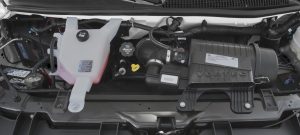
Also available – a compressed natural gas (CNG) version of the V8, which will appeal to fleet users who have access to CNG refueling facilities and to those who don’t because the CNG-powered Savana can run on gasoline, too. The CNG/gas “flex fuel” capability adds to the buy-in cost but gives you the option of not being dependent on gasoline – or diesel. Both of which may become much more expensive down the road or much less available.
Even if not, CNG burns very cleanly. The upside there is increased maintenance intervals and – usually – even longer engine life, because CNG-fueled engines don’t crud up as much internally, over time.
This van is a hoss. It can pull as much as 7,400 lbs. – substantially more than all the other large vans except for the Mercedes Sprinter – which can pull just barely more (7,500 lbs.) but only when equipped with its optional (and also a lot extra) 3.0 liter turbodiesel V6.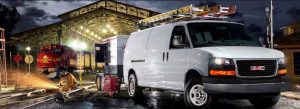
The 4.3 V6 and the 2.8 liter turbodiesel both come standard with eight speed automatics; the V8 is paired with a six-speed automatic, a real plus because it’s a simpler automatic that should last as long as the engine.
Mileage ranges from 11 city, 16 highway for V8 models to about twice that for turbodiesel models. But do all the math before you pick the diesel over the V8. It uses more gas but costs about $2,500 less to buy. On the other hand, the diesel should cost less over the long haul because it should haul for longer.
It may also be the best choice for in-city/stop-and-go service because of its tremendous low-speed torque.
The V8 makes big torque as well – but not until higher speed (RPM) which means more revving.
All the vans in this class are twice as long as the typical car; the Savana (and its Chevy-badged cousin) are the only ones that are quicker than most cars.
Equipped with the optionally available 6.0 liter V8, the Savana gets a dozen people to 60 in just under seven seconds. That is quicker than several sports cars – for example, the Subaru BRZ/Toyota 86 twins, which aren’t that quick.
Which is slightly embarrassing . . . for the twins.
Which can’t carry more than one passenger and have the advantage of weighing about 2,500 pounds less than a Savana van.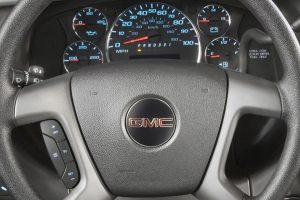
Even with the standard V6, the Savana isn’t slow – as its sort-of rivals, equipped with their standard engines, are.
There is also much to be said about the insulating effect of a body that is bolted to a frame – with a dozen rubber biscuits sandwiched in between. This layout used to be the signature. layout of luxury sedans. Nowadays, almost everything else is welded-together body-and-frame (unibody) which makes for a more rigid end product and (often) a less forgiving ride.
The Savana is, of course, a huge vehicle. But the driver sits pretty far forward relative to the hood, which makes this 244 inch-long vehicle seem not as long as it actually is. But it’s still almost four feet longer overall than a current full-sized minivan, such as Toyota Sienna or Honda Odyssey.
So, look twice – and one more time – before you back up.
At The Curb
Size matters – if you want to carry all your friends (or everything) at once, without needing another van.
Or another trip.
Those 244 inches of length translate into 252.2 cubic feet of interior space – which is almost twice the space of a current full-sized Sienna or Odyssey. Even with seats in place, the Savana’s available cargo space is almost as much as the Sienna’s or Odyssey’s without their seats in place (127.2 cubic feet).
The Savana’s more direct rivals – like the Benz Sprinter and the Ram ProMaster – are comparably roomy and offer “high roof” options that make it possible to stand upright in them, which is something the Savana doesn’t offer.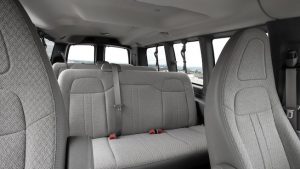
But the trade-off there is capability – and expense. The Ram can’t match the Savana’s towing capabilities – or rugged build layout.
The Benz can’t match the price – for comparable capabilities.
With that said, the Savana isn’t as nice as the Benz, which has the feel (and fit and finish) of a mutated E-Class. The steering wheel in the Sprinter looks like the same one that you’d find in the E-Class and ditto some of the switches, materials and so on.
The Savana – in base trim, at least – has the feel and general vibe of the jitney bus that takes you from the airport terminal to the rental car lot. Base trims come with 16-inch steel wheels (not a bad thing, actually), AC, power windows, locks and a two-speaker stereo.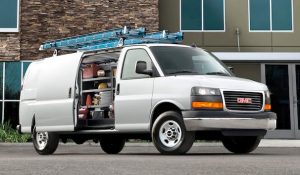
If you want more speakers – or a tilt wheel – they’re extra.
But, you can custom-conversion van the Savana into anything you want – and it’s a lot easier to add a 12 speaker upgrade audio system in place of a crappy factory stereo or captain’s chairs in place of bench seats than it is to install a V8 in place of a turbo four.
The Rest
A curious thing is that the Chevy-badged version of this van costs more than the GMC iteration – $34,900 to start. It’s curious because GMC is the more prestigious brand within the GM hierarchy; GMC models are usually a little nicer and offer additional amenities you can’t get in the Chevy-badged version of the same thing.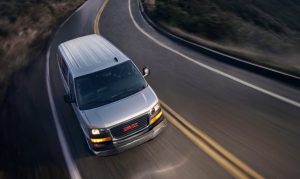
The Savana is an exception to that rule.
It costs less – and it’s better equipped as it sits.
The Bottom Line
There’s literally nothing else you can buy new that’s like the Savana – or the Express – which is probably why they have been able to get away with making the same thing for the past 25 years.
. . .
Got a question about cars, Libertarian politics – or anything else? Click on the “ask Eric” link and send ’em in!
If you like what you’ve found here please consider supporting EPautos.
We depend on you to keep the wheels turning!
Our donate button is here.
If you prefer not to use PayPal, our mailing address is:
EPautos
721 Hummingbird Lane SE
Copper Hill, VA 24079
PS: Get an EPautos magnet or sticker or coaster in return for a $20 or more one-time donation or a $10 or more monthly recurring donation. (Please be sure to tell us you want a magnet or sticker or coaster – and also, provide an address, so we know where to mail the thing!)
If you’d like an ear tag – custom made! – just ask and it will be delivered.
My latest eBook is also available for your favorite price – free! Click here. If that fails, email me at EPeters952@yahoo.com and I will send you a copy directly!


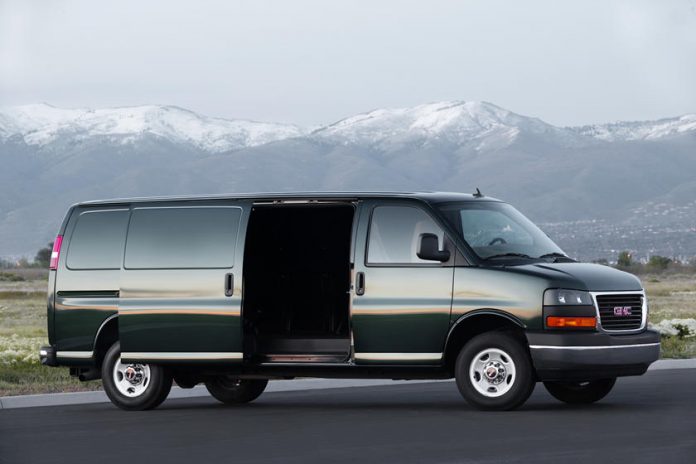



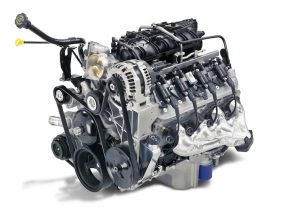
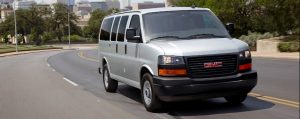







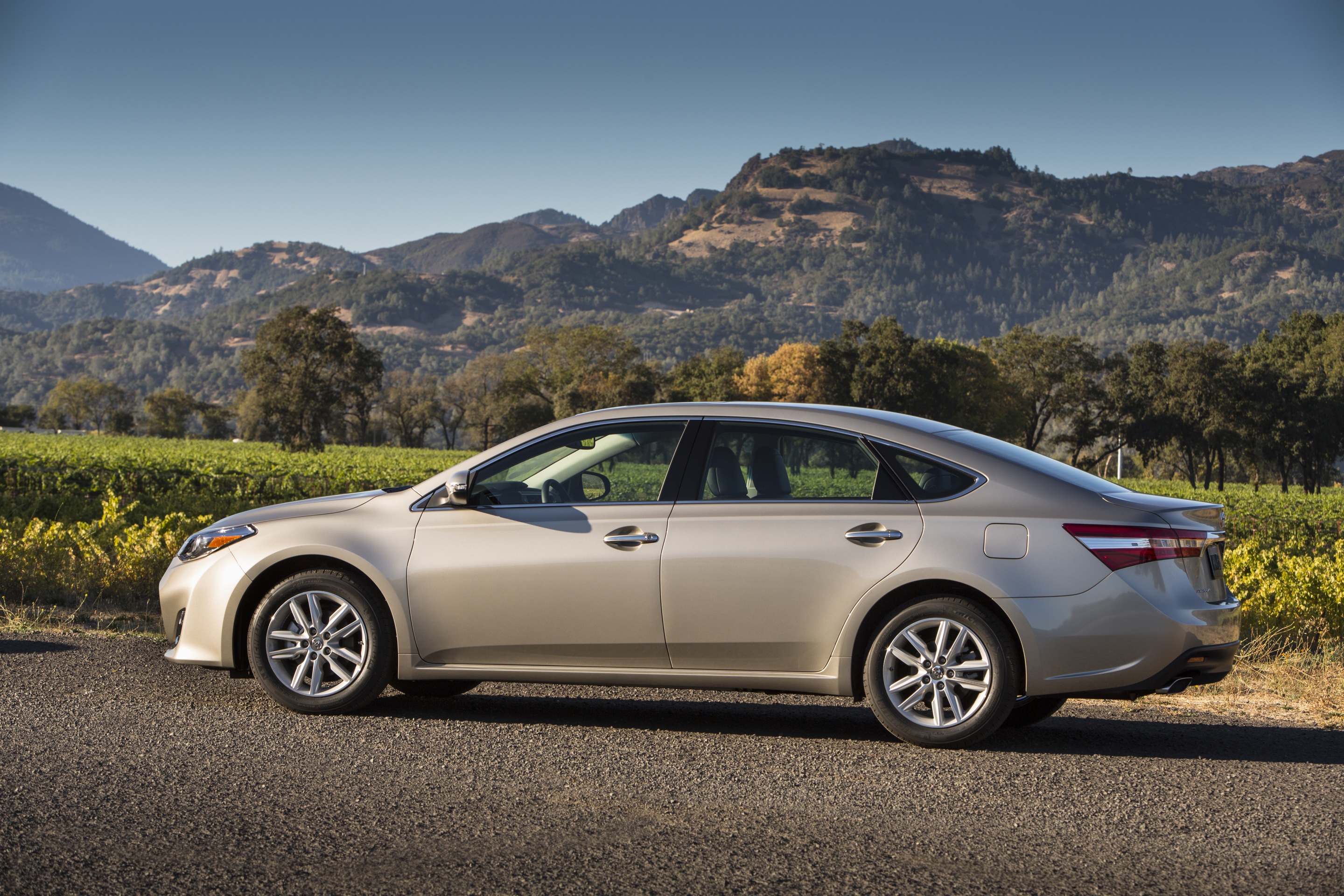
Who doesn’t want a full size mobile love palace?
Sorry, but keeping the 97 K2500 Suburban with the 7.4 and the 8600# gross package. Now that is a truck-hauls 8 people comfortably and gets 11-12 MPG doing it. About 7-8 hauling the RV. No safte-e-e-e-e ge-gaws. Can be worked on in the driveway. Does ride like a brick without a load in it, though.
Funny thing that I was laughing with my wife about one of these. It is the big asssed version with few miles. It looks like a better option than a short bus and would easily carry stuff to the plater and other subcontractors. I figure it could be loaded with almost a ton through the back doors to sit behind the rear seat.
What does a 3500 chebby truck go for with a cap and such?>>>LIKELY MORE>>>>damned keyboard>
If I bought the thing I would make my wife go to a second hand store to get me a chauffeur cap.
Maybe I could hang around the airport terminal to pick up girls.
It is still cheaper than a Harley and can carry one that usually quits, in the back with the seat folded down.
I don’t know what their load rating is but they have larger springs than 25 years ago. My 93 K3500 wasn’t that comfy till the big headache rack, heavy side rails, and a big tool box was stuffed with heavy stuff. I always had a compact jack and a dammit jack plus another toolbox under the cross-over box and still hauled 4,000 lbs+ in the bed while pulling a very overloaded 10,000 lb bumper pull trailer.
I’d say if you had some weight in front of the axle and behind it for 4 feet you could easily haul 2-3 tons. One ton trucks are really heavily sprung these days. I wouldn’t consider having one without 10 ply tires.
A friend has 14 ply tires on his F 350 and said it would beat you to death cause the tires have no give. Think he runs them on his 3500 dually Duramax too.
Eric, thanks for the sentimental journey. I didn’t realize GM still produced this design. I assumed it was long gone, as they rarely appear on the road near me.
As a father of ten, I bought the 1997 edition of this van in the 12-passenger configuration with the 5.7 liter V-8. We put about 200K miles on it before the engine failed and I downsized. But it was a nice ride for a large family while it lasted. Roomy and comfortable. My wife and kids mourned when it died. Ah, the memories.
Thanks, David!
In addition to being great for big families, these things are also great for doing burnouts!
The 4.3L wee six has come a long way if they are getting 276 hp out of it. I have a 1997 Cheyenne with a 4.3 that barely made 200 hp when new.
Hi Charles,
Indeed it has! If one were to transport this engine back to the mid-1990s, its horsepower rating would be higher than that of most V8s of the era. The tragedy is that today’s cars – ad trucks – are so heavy. Put that powerhouse engine into a new vehicle that weighs what a mid-’90s equivalent did then you’d have something!
I’ve noticed engines and transmissions don’t last nearly as long in vans as pickups. It’s definitely the attitude of the owner. I HAVE seen vans that were treated decently that had lots of miles on them mainly because the hood was up often and the oil and fluids were checked, something that seems to be a rarity among van owners.
Remember these vans as a kid, dad always had one since I was born to the time we left the US. Initially it was a basic one from the late 70s, with one of these round windows on one side, flat bed, carpeted, and a raised bed in the back. no chairs that I can remember, but we were kids so would just play around inside. The one we last had in the early 80s had a power sofa in the back that became a bed, captain chairs, tv, VCR, Nintendo, fridge (well cold box of some sort), and amazing captain chairs.
These were Ford Econoline vans (E150s) custom kitted by a company called Explorer. Back then we used to see them a lot, but dont know dont see them anymore when we go to the US? Always wondered where they went, I mean as kids they were brilliant…
Hi Nasir,
Those custom vans used to be everywhere when I was a kid in the ’80s. On TeeVee, too – remember Mr. T’s van? I had a friend who had one when I was in college; he had removed the service cover for the engine, so the V8 was literally in the passenger compartment, the back half exposed between the driver an passenger. We had fun in that thing!
I can go one better: the movie, “The Van”, from the 1970s!
2021 the GM vans get a bigger engine and over 400hp!!
I will take a cargo version out for a ride(my buddy works at a GM dealer)
I grew up in customized Dodge fullsize vans and my dad had the engines built up,cam/heads/intake/carb and these vans were very quick! they were pushing 400hp..1 had a 440 from the factory the other a 360 4bbl..My Dad was the cool Dad when I was in school (late 70’s early 80’s) when he picked me up..A few times he did John Force style burnouts with the 440 van black/black&red cragers and flares wicked van!!
Hi TG,
I dig! My dad didn’t have a van like that but one of my good friends did. It was the perfect tool for the things young guys like to do. I remember one road trip especially. How we survived – and weren’t jailed – is testimony to good luck and a better America. The thing was half full with cheap beer and bad pot; the other half with three of us and three girls we knew at the time. There was plenty of room for everything. We three took turns behind the wheel – and otherwise. By the time we got to the destination, there was a lot more space for that sort of thing as most of the beer was gone by then.
Dammit, I miss the ’80s. We lived in a way that is almost literally no longer possible today. The idea of being “locked down” and forced to wear Fear Masks? No way, man. Not in America.
Nice to see that there are real AMERICAN style vehicles still left!
I’m a younger guy (32) but I love these vans! Especially a few years ago when you could get AWD (snow belt). If I had the money, and a wife who didn’t hate vans, I’d buy one of these in a heartbeat! PS I didn’t know any new vehicle still had that “classic” gm radio from 25 years ago! Brings back memories…
Some friends had one that was smaller 30 years ago. It was AWD and they pulled a boat all the time and loved it. It was a 3.8 V6, auto. It may have been built on the S10 platform but was one helluva lot better than the pickup.
Chevy “Astro” van ????
AWD != 4WD Sometimes you just want/need the real thing with low range.
Are most new vans this expensive? (~$30,000 FRN)
I thought they should be less costly (~$20 to $22k). (At least for basic models)
Hi Mith,
You can pick up a mini van for around $20k – models like the Ford Transit and Nissan NV – but not a full-size van. These vans are actually super-sized (much larger than full-sized vans like the Toyota Sienna/Honda Odyssey) but they are also super-duty, with V8s available and capable of real work, too!
If I were forced to buy a new vehicle, this would be it. Get it in white panel job, put some nondescript sign on it and have it RV’s out the wazoo. It can be done cheap since a friend did it and made every everything in it except the rotating recliners for passenger seats. Shower, head, stove, microwave, aux. heat and cooling and beds. Get this bad boy in a K3500 and be able to go offroad and camp out(which he did). His wife made custom cushions and he made custom benches and all sorts of things. I was impressed except it was a Dodge.
Vans are a pain in the Butt to work on, but it is good that they are still making this one.
hmmmm, I thought GM’s old 6.0L was done now that they have the new 6.6L gasser for their HD 2500+ trucks?
If it’s still the old 6.0 from the early 2000’s, it was and still is a great workhorse engine. I’m still running one with 250K on it with original trans. The rest of the truck is falling apart but that 6.0 keeps working hard.
Yeah the old van certainly looks dated, but I guess the price to work value is probably why I still some new ones from time to time.